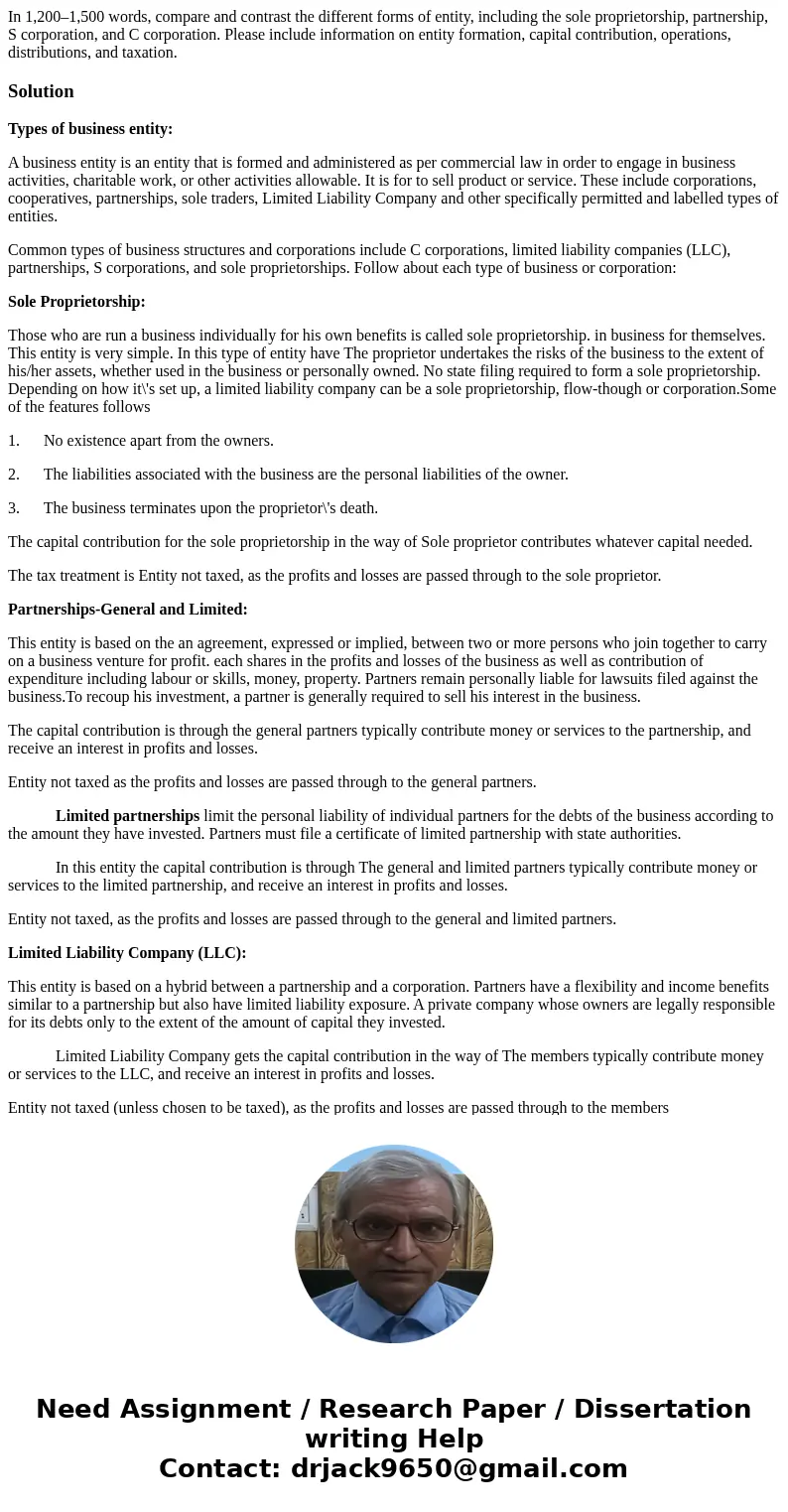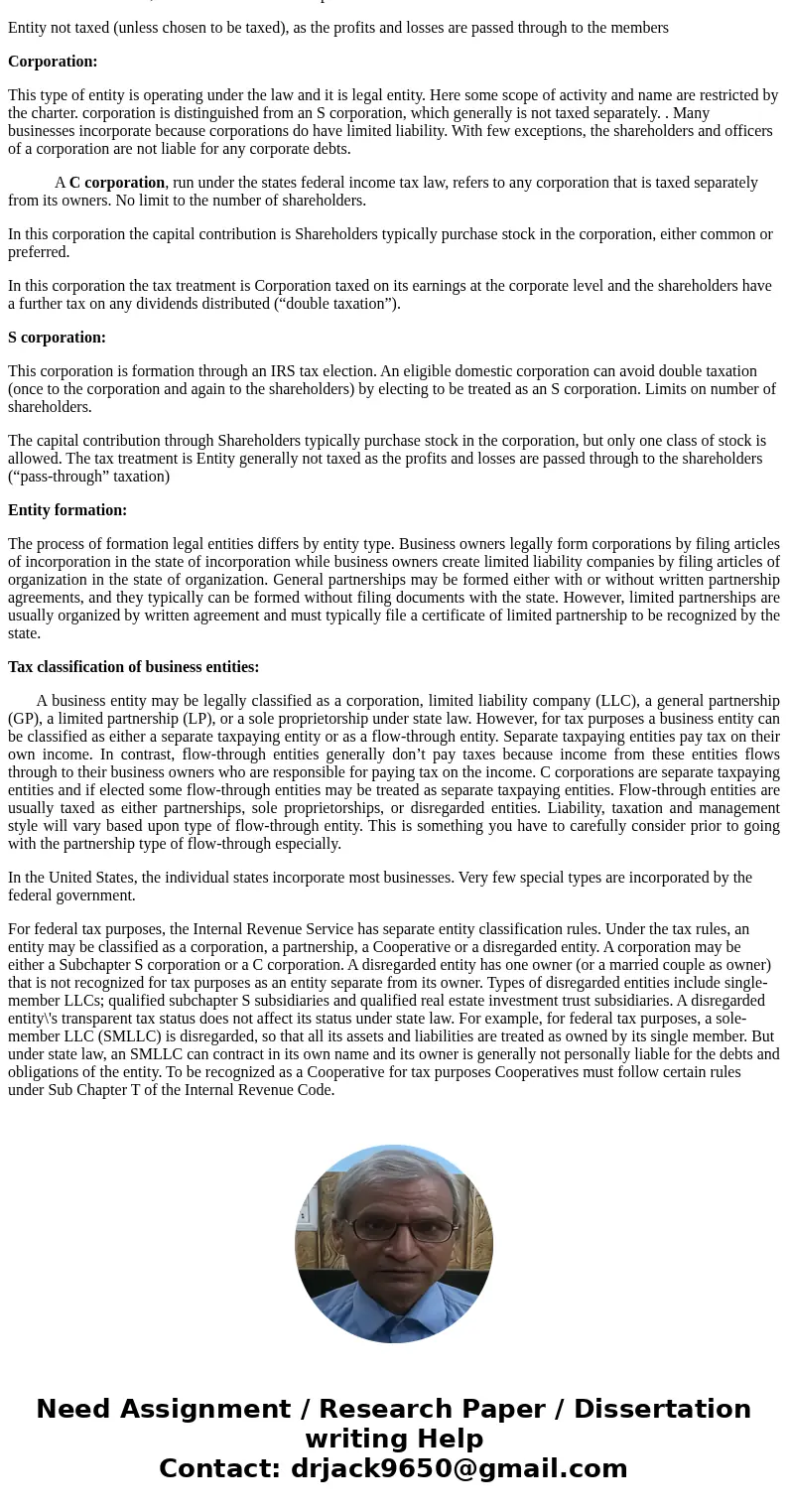In 12001500 words compare and contrast the different forms o
In 1,200–1,500 words, compare and contrast the different forms of entity, including the sole proprietorship, partnership, S corporation, and C corporation. Please include information on entity formation, capital contribution, operations, distributions, and taxation.
Solution
Types of business entity:
A business entity is an entity that is formed and administered as per commercial law in order to engage in business activities, charitable work, or other activities allowable. It is for to sell product or service. These include corporations, cooperatives, partnerships, sole traders, Limited Liability Company and other specifically permitted and labelled types of entities.
Common types of business structures and corporations include C corporations, limited liability companies (LLC), partnerships, S corporations, and sole proprietorships. Follow about each type of business or corporation:
Sole Proprietorship:
Those who are run a business individually for his own benefits is called sole proprietorship. in business for themselves. This entity is very simple. In this type of entity have The proprietor undertakes the risks of the business to the extent of his/her assets, whether used in the business or personally owned. No state filing required to form a sole proprietorship. Depending on how it\'s set up, a limited liability company can be a sole proprietorship, flow-though or corporation.Some of the features follows
1. No existence apart from the owners.
2. The liabilities associated with the business are the personal liabilities of the owner.
3. The business terminates upon the proprietor\'s death.
The capital contribution for the sole proprietorship in the way of Sole proprietor contributes whatever capital needed.
The tax treatment is Entity not taxed, as the profits and losses are passed through to the sole proprietor.
Partnerships-General and Limited:
This entity is based on the an agreement, expressed or implied, between two or more persons who join together to carry on a business venture for profit. each shares in the profits and losses of the business as well as contribution of expenditure including labour or skills, money, property. Partners remain personally liable for lawsuits filed against the business.To recoup his investment, a partner is generally required to sell his interest in the business.
The capital contribution is through the general partners typically contribute money or services to the partnership, and receive an interest in profits and losses.
Entity not taxed as the profits and losses are passed through to the general partners.
Limited partnerships limit the personal liability of individual partners for the debts of the business according to the amount they have invested. Partners must file a certificate of limited partnership with state authorities.
In this entity the capital contribution is through The general and limited partners typically contribute money or services to the limited partnership, and receive an interest in profits and losses.
Entity not taxed, as the profits and losses are passed through to the general and limited partners.
Limited Liability Company (LLC):
This entity is based on a hybrid between a partnership and a corporation. Partners have a flexibility and income benefits similar to a partnership but also have limited liability exposure. A private company whose owners are legally responsible for its debts only to the extent of the amount of capital they invested.
Limited Liability Company gets the capital contribution in the way of The members typically contribute money or services to the LLC, and receive an interest in profits and losses.
Entity not taxed (unless chosen to be taxed), as the profits and losses are passed through to the members
Corporation:
This type of entity is operating under the law and it is legal entity. Here some scope of activity and name are restricted by the charter. corporation is distinguished from an S corporation, which generally is not taxed separately. . Many businesses incorporate because corporations do have limited liability. With few exceptions, the shareholders and officers of a corporation are not liable for any corporate debts.
A C corporation, run under the states federal income tax law, refers to any corporation that is taxed separately from its owners. No limit to the number of shareholders.
In this corporation the capital contribution is Shareholders typically purchase stock in the corporation, either common or preferred.
In this corporation the tax treatment is Corporation taxed on its earnings at the corporate level and the shareholders have a further tax on any dividends distributed (“double taxation”).
S corporation:
This corporation is formation through an IRS tax election. An eligible domestic corporation can avoid double taxation (once to the corporation and again to the shareholders) by electing to be treated as an S corporation. Limits on number of shareholders.
The capital contribution through Shareholders typically purchase stock in the corporation, but only one class of stock is allowed. The tax treatment is Entity generally not taxed as the profits and losses are passed through to the shareholders (“pass-through” taxation)
Entity formation:
The process of formation legal entities differs by entity type. Business owners legally form corporations by filing articles of incorporation in the state of incorporation while business owners create limited liability companies by filing articles of organization in the state of organization. General partnerships may be formed either with or without written partnership agreements, and they typically can be formed without filing documents with the state. However, limited partnerships are usually organized by written agreement and must typically file a certificate of limited partnership to be recognized by the state.
Tax classification of business entities:
A business entity may be legally classified as a corporation, limited liability company (LLC), a general partnership (GP), a limited partnership (LP), or a sole proprietorship under state law. However, for tax purposes a business entity can be classified as either a separate taxpaying entity or as a flow-through entity. Separate taxpaying entities pay tax on their own income. In contrast, flow-through entities generally don’t pay taxes because income from these entities flows through to their business owners who are responsible for paying tax on the income. C corporations are separate taxpaying entities and if elected some flow-through entities may be treated as separate taxpaying entities. Flow-through entities are usually taxed as either partnerships, sole proprietorships, or disregarded entities. Liability, taxation and management style will vary based upon type of flow-through entity. This is something you have to carefully consider prior to going with the partnership type of flow-through especially.
In the United States, the individual states incorporate most businesses. Very few special types are incorporated by the federal government.
For federal tax purposes, the Internal Revenue Service has separate entity classification rules. Under the tax rules, an entity may be classified as a corporation, a partnership, a Cooperative or a disregarded entity. A corporation may be either a Subchapter S corporation or a C corporation. A disregarded entity has one owner (or a married couple as owner) that is not recognized for tax purposes as an entity separate from its owner. Types of disregarded entities include single-member LLCs; qualified subchapter S subsidiaries and qualified real estate investment trust subsidiaries. A disregarded entity\'s transparent tax status does not affect its status under state law. For example, for federal tax purposes, a sole-member LLC (SMLLC) is disregarded, so that all its assets and liabilities are treated as owned by its single member. But under state law, an SMLLC can contract in its own name and its owner is generally not personally liable for the debts and obligations of the entity. To be recognized as a Cooperative for tax purposes Cooperatives must follow certain rules under Sub Chapter T of the Internal Revenue Code.


 Homework Sourse
Homework Sourse